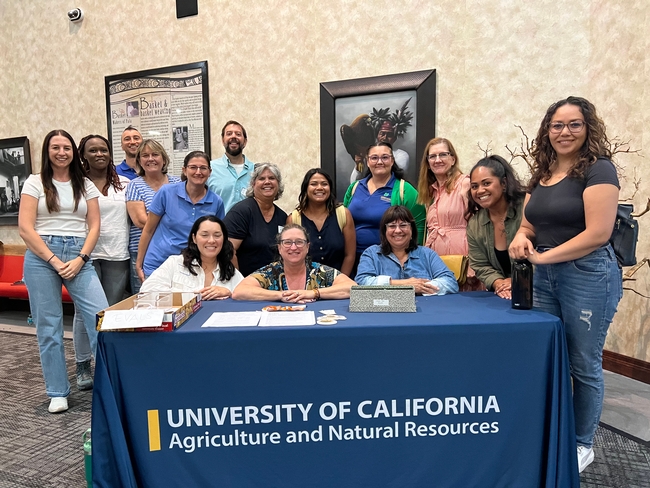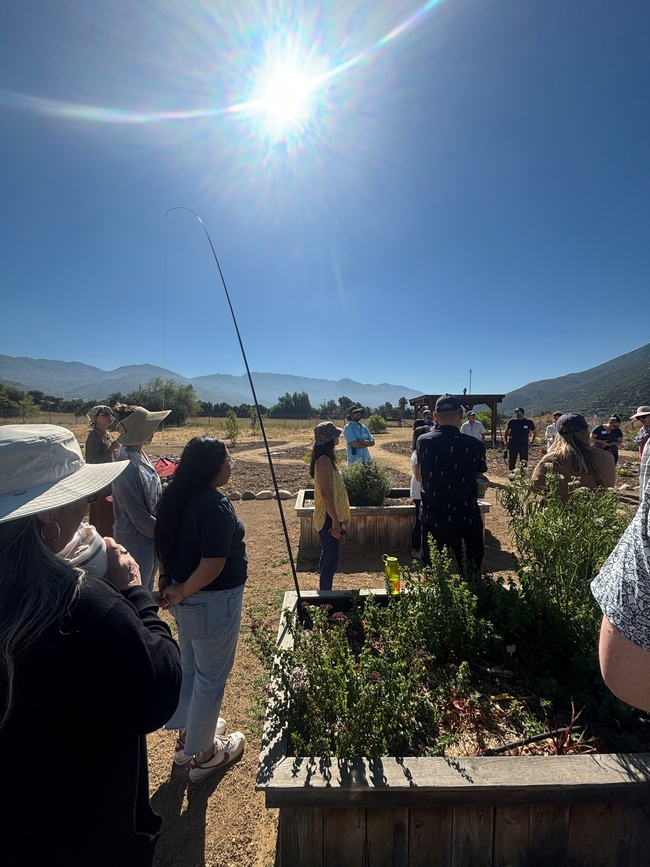Chris McDonald, Inland and Desert Natural Resources advisor, brought together 80 people from various federal, state, county, and university affiliations at the Pala Band of Mission Indian Administrative Building in Pala for the Southern California Tribal Partnerships Workshop. The Pala Tribal community graciously welcomed us to their community with a homemade lunch and an invocation by Pala Tribal Member, Eric Ortega.
The two-day event kicked off with foundational knowledge about Pala Tribal life, Tribal civics, and building partnerships with John “Bud” Machado, Cupeño Language Instructor for the Tribe, Shasta Gaughen, Environmental Director and Tribal Historic Preservation Officer, and Heidi Brow, Water Resource Specialist in the Environmental Department.
For many in the audience, the knowledge gained was new and nuanced. For example, did you know that despite a Tribe's sovereignty, meaning they are recognized as an independent nation, the federal government is required to serve as a ‘guardian'? This reality is truly horrendous considering the genocide of native people and the stealing of their lands.
The nuance of this Civics 101 is a minimum foundation for how outsiders to the Tribe need to, first, do their own learning before attempting any partnership with a Tribe. Second, it is a reminder that partnerships must be based on what the Tribe needs and, third, that all efforts need to involve the Tribal community every step of the way. Overall, the presentations offered a clear example of what many of us in the audience believe to be missing in education.
We ended the first day with McDonald's advice on studying your organization's history. ]Knowing the history of your organization will help to identify how it has affected the Indigenous communities where you currently or will work, and offer guidance on how to avoid repeating a cycle of harm.
I spent the evening beginning to reflect on my personal and professional communities. I thought about how I could build out this living history and build safe spaces for exploration of how to create trust through training and composing questions that allow us to hear the words of the Native communities in California.
Day two started in the demonstration garden located outside the Pala Administration building. Attendees had the opportunity to take a walking field trip of the on-ground projects being accomplished with partnerships. Upon entering the garden, where cherry tomatoes were ripening and a few workers were shoveling dirt from one pile to another, we learned how the Pala Tribe gained access to this trust land and their vision to make it an educational space for both gardening and culture.
The demonstration garden is in the process of building out its composting structures and future goal for a turtle pond. Next on our tour was the aquaponics demonstration site, which I found to be the most interesting. Learning about the infrastructure and financial resources required to get the site off the ground was fascinating. I cannot wait to see it fully in action with its solar energy source and the proliferation of greens and reeds for use by the Tribe. We ended our tour with a walk around the sports complex adjacent to the Pala Administration Building to see the pollinator garden and the Trujillo Creek restoration project.
Perfect timing for us to return inside for another mouthwatering lunch provided by the Pala Tribe and a conversation around the Natural Resources Conservation Service and Pala partnership on a fuels reduction project. Our afternoon gave us the opportunity to learn directly from the following Tribal members and affiliates: Will Madrigal Jr. from Climate Science Alliance, Lisset Valencia-Pigman and Andrew Pigman from Condor Visual Media, Jeremy Zagarella from TriHydro, Lena Ortega from the Intertribal Agriculture Council, and Tina Fernandez from the Pala Environmental Department.
Each person freely gifted us their knowledge and expertise. Lena Ortega's presentation awoke in me the need for honesty in assessing my motives through the lens of my actions. “How many of you know the five tribes closest to where you work?” Lena asked. “How many of you have attended an open event in the tribal community you wish to partner with in the last month or two?”, “Do you know the history of the Tribe?”, she continued. More questions were calling us out for our passive expectations to gain knowledge and partnerships without the work, something I appreciated then and now.
We ended our time together in circles of learning and sharing - providing another opportunity to build connections, deepen learning, and find ways to collaborate and co-create as organizations with the Tribes in our communities.
I am looking forward to our NorCal Tribal Partnerships Workshop in August in Davis. I hope to see many more folks join in this learning and be challenged to learn more about the land where we reside and how we can show respect to those whose land and knowledge we aspire to partner with in the future.

